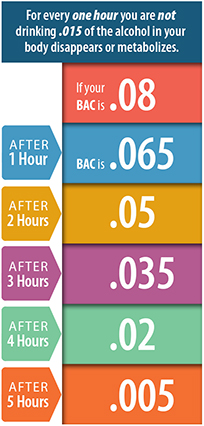How Long Does Alcohol Stay in Your System?

Alcohol remains a popular pastime in the U.S.: 65 percent of Americans said they drink and 25 percent said they occasionally “drink too much,” in a recent Gallup poll. But when excess alcohol is in your system—as can be the case in instances of binge or heavy drinking or when mixing alcohol with other drugs, such as sleeping pills—you can endanger both the health and safety of yourself and others. That is evidenced by the following data from the National Institute on Alcoholism and Alcohol Abuse (NIAAA), which identifies alcohol as a culprit in:
- 60 percent of fatal burn injuries, drownings and homicides
- 50 percent of severe trauma injuries and sexual assaults
- and 40 percent of fatal motor vehicle crashes, suicides and fatal falls.
Knowing how long alcohol stays in your system can therefore help you protect yourself and others from the potential dangers, like drunk driving. This article will provide you with in-depth information, including firsthand input from alcoholism experts, on:
- the time it takes for alcohol to leave your system
- various factors that can influence your rate of alcohol metabolism
- the mechanics of how alcohol is metabolized
- what constitutes dangerously high blood alcohol concentration levels
- and how long alcohol shows up in drug tests
 Time It Takes for Alcohol to Leave Your System
Time It Takes for Alcohol to Leave Your System
As a general rule, for every hour you are not drinking, .015 of the alcohol in your body leaves your system, as this handy chart from Home Health Testing reveals. (This is a rough approximation, since everyone absorbs and metabolizes alcohol at varying rates, depending on certain variables, such as weight. For more on these factors, read on.)
Say, for example, that your blood alcohol concentration (BAC) is .08 percent. (It is illegal to drive at a BAC of .08 or higher in all 50 states.) After one hour of not drinking, your BAC would fall to .065. After two hours of not drinking, it would fall to .05—then to .035 after three hours, to .02 after four hours, and to .005 after five hours. In other words, if your BAC is .08, it would take 5.33 hours for alcohol to leave your system.
What Is a Dangerous Blood Alcohol Concentration Level?
The only really accurate way to determine your BAC is via an alcohol test such as a breathalyzer. In the absence of a breathalyzer or other test, this blood alcohol level chart from Nolo provides an estimate of how many drinks it takes to get to a BAC of .08, based on your weight.
And it turns out that you don’t have to drink that much to land a BAC of .08 percent or higher. As illustration, if you weigh 120 pounds, drinking more than just two five ounce glasses of wine can get you there.
What is a “dangerous blood alcohol concentration level”? Most certainly anything nearing .08 percent or above, if you need to get behind the wheel; but even a significantly lower BAC of .02 percent can have adverse effects on your driving—specifically, a decline in your visual function (“rapid tracking of a moving target”), a decline in your ability to perform two tasks at the same time, and impaired judgment, according to a guide to alcohol impairment and the “ABC’s of BAC,” from the National Highway Traffic Safety Administration (NHTSA). (See especially the chart showing the effects of alcohol at different BAC’s, starting at .02 percent.)
At a BAC of .05 percent, typical effects (according to the NHTSA) include:
- Exaggerated behavior
- Loss of small muscle control
- Impaired judgment
- Lower alertness
- Unusually good feeling
At a BAC of .08 percent, the effects are:
- Poor muscle coordination (balance, speech, vision, hearing, reaction time)
- Impaired judgment, self-control, reasoning, and memory
- Compromised ability to detect danger
By the time a person reaches a BAC of .15 percent, they experience:
- Far less muscle control
- Vomiting (unless they have a high alcohol tolerance)
- Significant loss of balance
Extremely Dangerous BAC Levels
Dr. Edward Zawadzki, now the medical director at Beach House Center for Recovery, recalled treating patients during his residency who had been rushed into the ER with a BAC as high as .30, .40 and even .50. He says that when patients’ BACs are at these extreme highs, that’s when they develop intoxicated delirium … “they’re so intoxicated that they can develop brain dysfunction, are in a stupor to the point they need intubation, or are in agitated delirium—meaning so incredibly violent that they need to be put in restraints and medicated with Haldol, because they’re attacking staff or patients.” (Haldol is an antipsychotic medication.)
In one instance, Dr. Zawadzki recalled, a patient with an extremely high BAC (of .29 or above) came into the ER and died from sleep apnea.
Such extreme cases usually end up in the ER, according to Dr. Zawadzki: “If patients are that bad, they’re usually not eligible for detox,” he explained. “Many detox facilities have a limit regarding what they can do in a detox setting. We [Beach House Center for Recovery] don’t have a specific cut-off, but if someone comes in with a .29 BAC, in many cases we’ll send them to the ER: we don’t know if their respirations will decrease and they could die in their sleep from apnea.”
There are exceptions to this general rule. If someone has a BAC of .29 and is still totally coherent, Beach House may admit them and closely monitor their BAC and vitals at hourly intervals.
What Influences Rates of Alcohol Metabolism
“Metabolism” refers to the process by which alcohol is converted by the body into substances that are either more or less toxic, and, in turn, eliminated from your system. Rates of alcohol metabolism can vary on the basis of other variables besides body weight (which is a big one, as explained above). These influencing factors have been summarized in a detailed “Alcohol Alert” from the NIAAA:
- Food – One study found that subjects who drank alcohol after a meal consisting of fat, protein, and carbohydrates absorbed the alcohol about three times more slowly than when they drank on an empty stomach.
- Gender – Women metabolize alcohol more slowly than men, probably because of a lower water-body mass percentage and less active ADH (an alcohol metabolizing enzyme).
- Genetics – Different people have different variations of the two key enzymes involved in metabolizing alcohol, thanks to their genetic make-up. Some people can also have a higher built-in tolerance for alcohol (also because of genetic history).
- Race and liver mass – Some studies have found differences between races in the rate of alcohol elimination from the body, and have posited that liver mass may be a correlating explanation for these differences.
- The co-occurring use of medications – Certain medications can impact the rate at which your body eliminates alcohol, by slowing down the rate at which ADH processes alcohol.
- The proportion of alcohol in any given drink
How Alcohol is Metabolized
While alcohol is metabolized quite quickly relative to other drugs of abuse, this fact does not make alcohol safer to consume than other drugs of abuse. In fact, the way in which alcohol is metabolized may make it more dangerous for your health than other drugs.
Two key enzymes, ADH (alcohol dehydrogenase) and ALDH (aldehyde dehydrogenase), are responsible for metabolizing alcohol, by helping to break down alcohol molecules into smaller parts that can then be eliminated. The toxic byproducts of this process of molecular breakdown are what reportedly can lead to a range of health problems, from alcoholic liver disease to pancreatitis and cancer.
One such intermediate byproduct is a potent toxin known as “acetaldehyde.” While acetaldehyde is “short-lived, usually existing in the body only for a brief time before it is further broken down into acetate,” according to a NIAAA fact sheet, “it has the potential to cause significant damage” to your cells and tissues in the liver, pancreas, brain and elsewhere.
How Long Alcohol Shows Up in Drug Tests
There are various drug tests for alcohol, including breath, blood, urine and hair tests. These can usually detect alcohol in your system anywhere between 12 to 48 hours after your last drink. The EtG urine alcohol test can confirm alcohol ingestion as long as three to four days after intake. Hair follicle tests can detect alcohol within a 90-day window following last use, however.
If you have questions specifically about Alcohol Withdrawal or Alcohol Detox, these Learning Center articles could help answer them:


 Time It Takes for Alcohol to Leave Your System
Time It Takes for Alcohol to Leave Your System